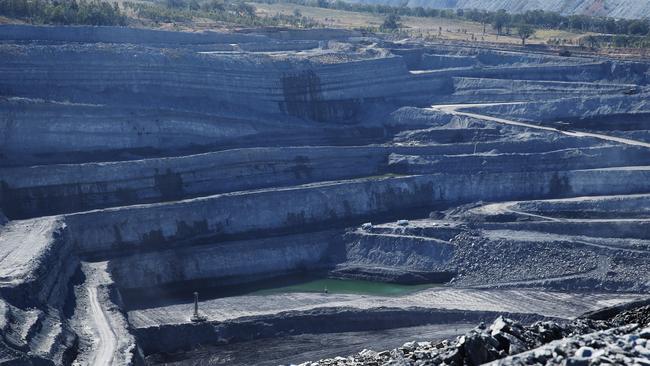Carbon ‘footprinting’ could accurately measure countries’ emissions
Australia has one of the worst records in this space but there’s a surprising loophole, which if fixed, could see us solve our wicked problem.

Climate Change
Don't miss out on the headlines from Climate Change. Followed categories will be added to My News.
OPINION
As the world prepares to negotiate a pathway to net-zero emissions at the Glasgow climate summit in November, two leading polluters continue to escape scrutiny, highlighting the need for a new way to count emissions.
Every year, countries submit their greenhouse gas emissions inventory to the United Nations Framework Convention on Climate Change (UNFCCC) as part of the Paris Agreement to limit global warming to 1.5-2⁰C by 2100.
But two huge and growing contributors are left off the reports and are not counted towards any country’s emissions totals — international aviation and shipping.
Yet a relatively new approach, called footprinting (i.e. our carbon footprint), assigns emissions caused by international trade to the importing country, and it could be good news for Australia’s pitiful emissions ranking.
Trade ‘loophole’ that needs to be closed
With greenhouse gases emitted outside of territorial borders, the current approach the UNFCCC follows is to relegate the impact of international aviation and shipping as a memo in the ranking of country emissions. But they are otherwise unaccounted for by the Conference of Parties and no country has to take responsibility for them.
By this measure, when international shipping is counted in the same way as a country, it is ranked as the sixth biggest emitter, trailing Japan, while aviation is 10th, just after South Korea and beating even Canada and Saudi Arabia. And before the coronavirus pandemic, tourism – of which air travel is a key component – was growing faster than international trade.
Time Is Now is part of news.com.au’s partnership with the Monash Climate Change Communication Research Hub, looking at the impacts of climate change across Australia by 2050


This loophole is one reason why carbon dioxide and equivalent (CO2-e) emissions keep rising and we are on track for significant overshoot.
As well, the current system allows for “carbon leakage” – where rich nations outsource production to poorer nations.
The US, for example, likes to point out that China is the world’s biggest emitter, but it is polluting the atmosphere in large part through supporting the lifestyles of affluent nations such as America itself, a net-importing nation whose citizens generate twice as many emissions as China per capita.
What is footprinting?
Australia is currently positioned as the top-emitting country per capita in the OECD. But this is largely because much of our emissions come from producing fossil fuels that are sent overseas.
The Australian Government recently revealed a new system for stocktaking emissions that could change this — consumption-based accounting, referred to as footprinting.
Rather than simply calculating production within territorial borders, under this approach, emissions are traced to the end consumer, wherever they are in the world, and counted in that county’s total.
If this system was used, Australia’s emissions ranking could plummet, turning the spotlight on the countries demanding our fossil fuels.
We are heading towards runaway climate change because of unsustainable consumption, so how we account for greenhouse gas emissions like carbon dioxide and methane is critical.
For example, when the Stockholm Environment Institute with the centre for Integrated Sustainability Analysis at the University of Sydney established the carbon footprint of the UK for its government more than a decade ago, rather than emissions falling as had been reported, they were found to be increasing, when outsourcing overseas is taken into account. This led the BBC to declare the UK in “delusion” over emissions.
The need for a global approach is also demonstrated by the shifting of “dirty” industries overseas to escape local regulations. It’s one of the reasons behind claims if Australia stopped exporting our fossil fuels today, production in other countries would fill the void.

Closing such loopholes is a key benefit of footprinting, which in recent years has overcome challenges through increased data availability and by developing supercomputing resources to interrogate billions of supply chains. Footprinting is used by organisations like the OECD, UN Statistics Division, IMF, WTO and Eurostat because of its ability to unravel upstream supply chains in our interdependent world.
Australia’s ‘wicked’ problem
Last year, the first comprehensive carbon footprint of New Zealand showed about half its emissions are hidden through imported goods and services, in line with research of many developed nations. Australia, however, is perhaps more aligned with developing nations, in that we export more emissions than we import, largely because we are one of the world’s leading suppliers of coal.
It may have appeared self-interested when Prime Minister Scott Morrison this year announced greenhouse gas emission figures that excluded exports. Yet the details show Australia is trialling footprinting. Indeed, excluding exports, while including imports, is a key aspect of footprinting, which relegates emissions from exports to the countries that import them.
Australia, in trying to solve our wicked problem, could become a crucial advocate for developing nations and small island states – which are also more vulnerable to climate change. It’s the equivalent of “don’t shoot the messenger” i.e., net-exporting (and generally poor) countries. The idea being that rather, the countries whose demand is driving the emissions are best-placed to affect change.
Of course, in this climate emergency, every country must act urgently. Within countries, too, organisations and individuals can calculate their carbon footprint and see where the hot spots lie – be it beef, energy or tourism – to make the biggest difference.
Globally, the biggest impact can be made by bringing footprinting into international climate negotiations. Footprinting has emerged as the most likely contender to improve the system overseen by the UNFCCC and can complement the current territorial approach, through shared consumer and producer responsibility.
With footprinting, the question of how much we are emitting expands beyond our country’s borders to the global impact of our consumption, including imports “made in China” and international air travel.
It may be an inconvenient truth for some but therein lies the solution; in footprinting the impacts of our economic activity we just might be able to stop catastrophic climate change.
Vivienne Reiner is a Master of Sustainability candidate at the University of Sydney, where Arunima Malik lectures for the centre for Integrated Sustainability Analysis (ISA) and the Business School.
Originally published as Carbon ‘footprinting’ could accurately measure countries’ emissions


